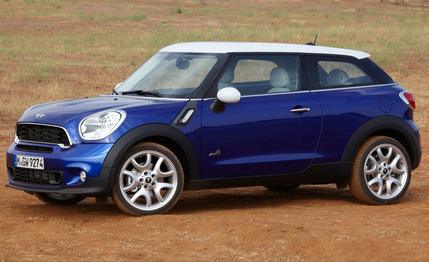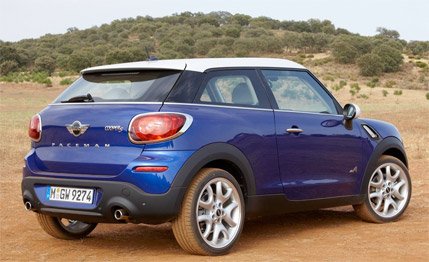
 Prototype Drive
Prototype Drive
When unveiling the Paceman concept at the 2011 Detroit auto show, Mini touted it as a “totally new category of car” thanks to an “innovative body concept.” The concept hardly lived up to the rhetoric and now that it has morphed into a production car, it can be a challenge to distinguish it at first glance from the Countryman. The front end, in fact, is identical to that mega-Mini five-door; its wheelbase hasn’t changed; even the interior incorporates precious few alterations, all destined to appear in the Countryman anyway.
The differences are in the greenhouse and the rear. Compared with the Countryman, the Paceman’s roof is lower and hints at the “baseball cap” style of the smaller Mini Coupe, and the rear lights and trunk are entirely different. The garish chrome strip around each taillight recalls that of a Buick Enclave, and the “Paceman” moniker is plastered along the tailgate in a way that makes ’90s Pontiacs seem like paragons of understatement.
Thanks mainly to its chopped roof, the Paceman is 1.6 inches lower than the Countryman and its center of gravity has dropped by an inch. Despite being 44 pounds lighter than its five-door sibling, the Paceman prototype we drove—a Cooper S ALL4 model—felt tighter and more substantial than the flimsy, rattle-prone Countryman. We preferred the slightly heavy weighting of this all-wheel-drive Paceman’s electric power steering to that of a front-drive Countryman provided for comparison. Body roll was considerably less pronounced; the car simply handled better.


Better, but hardly kart-like. The Paceman is no sports car, and the engine doesn’t provide many thrills, either. The 181-hp 1.6-liter turbo struggles against a 3200-pound curb weight. Given the additional mass and friction of the all-wheel-drive system, the Paceman can’t keep up with compact performers such as the Volkswagen GTI or a regular Mini Cooper S. We still recommend the all-wheel drive anyway, if only to avoid the front-driver’s torque-steer affliction.
In maintenance of its sporting pretensions, the Paceman is strictly a four-seater, its left and right seats separated by a reconfigurable center console. Ingress and egress are easy and there is plenty of room for four adults. Compared with the Countryman, cargo space is further compromised. The Paceman’s trunk will be even smaller than the Countryman’s 14 cubic feet with the seats in use and 41 cubic feet with the backrests folded. For reference, the VW GTI offers a maximum of 46 cubic feet and a seats-in-use volume of 15. The ergonomically challenged dashboard with its grotesquely oversize speedometer carries right over, but one major improvement in the Paceman will be seen soon on the Countryman as well: The virtually inaccessible window switches migrate from the center stack to the doors.
Mini will launch the Paceman in the first quarter of 2013 with a price estimated at $1500 higher than the Countryman’s, or about $24,500. The U.S. market will see the 121-hp Cooper, the 181-hp Cooper S, and the 181-hp all-wheel-drive Cooper S ALL4. Down the road, there will be a high-powered John Cooper Works version. As a niche variation on a niche model within a niche brand, we doubt the Paceman will spark an entirely new category of vehicles; its appeal is to loyalists who’ve outgrown the Mini Clubman but wouldn’t be caught driving something so SUV-like as a Countryman. Cue applause from all seven of them.